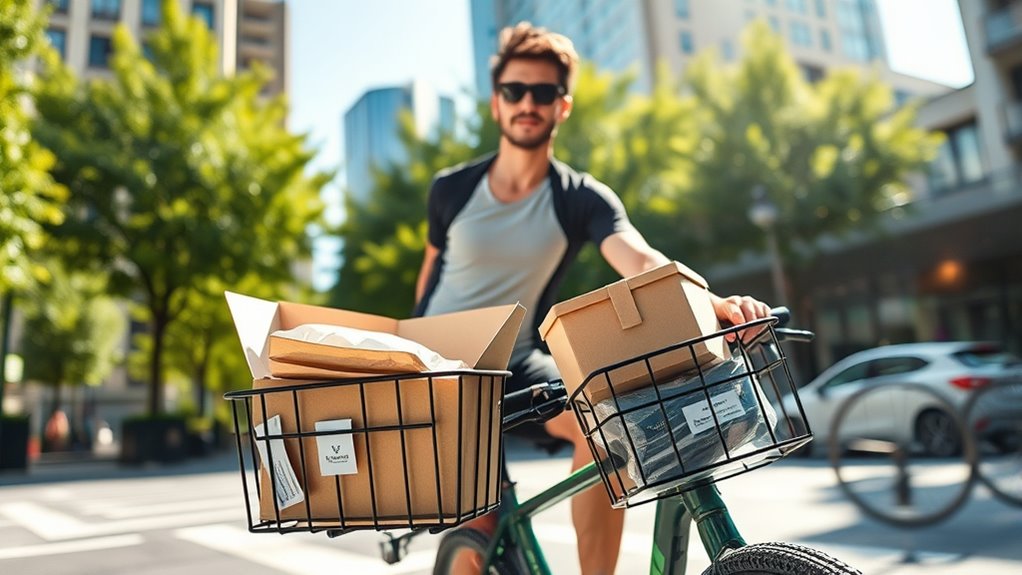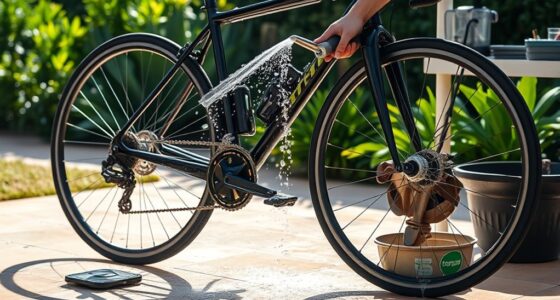To cut packaging waste in cycling, choose brands that use sustainable, biodegradable, or recycled materials. Opt for minimal, efficient packaging that can be reused or easily recycled. Support companies committed to eco-friendly practices and provide feedback to encourage better environmental standards. Consider repurposing packaging for storage or other uses instead of discarding it. Staying mindful of your choices helps reduce waste and promotes industry shifts toward greener solutions—continue to explore ways to make your cycling practices even more eco-conscious.
Key Takeaways
- Choose products with biodegradable, recycled, or minimal packaging to reduce waste in cycling gear and accessories.
- Advocate for brands that utilize eco-friendly packaging materials and support sustainable manufacturing practices.
- Opt for compact, efficient packaging designs that minimize material use and waste during shipping and storage.
- Reuse or recycle packaging materials, such as cardboard boxes or paper, to extend their lifecycle and prevent landfill buildup.
- Provide feedback to companies encouraging adoption of environmentally responsible packaging solutions in the cycling industry.

Cycling has become a popular and eco-friendly way to stay active, but it also brings challenges related to packaging waste. As a cyclist, you might notice how many products, accessories, and parts come wrapped in excess packaging that often isn’t recyclable or biodegradable. Reducing this waste starts with understanding the importance of sustainable materials and thoughtful packaging design. When manufacturers choose eco-friendly packaging, they minimize environmental impact and make it easier for you to dispose of waste responsibly.
Sustainable materials are essential in tackling packaging waste in cycling. Instead of traditional plastics or non-recyclable materials, look for products packaged with biodegradable cardboard, recycled paper, or compostable elements. These materials break down naturally, reducing landfill accumulation and pollution. By supporting brands that prioritize sustainable materials, you’re encouraging a shift toward more eco-conscious manufacturing. This not only benefits the environment but also reduces the energy consumption involved in producing and disposing of packaging. When you purchase cycling gear or accessories, check labels or product descriptions that highlight the use of recycled or biodegradable packaging. Your choices can influence brands to adopt more sustainable practices.
Packaging design also plays a fundamental role in waste reduction. Well-designed packaging minimizes material use without sacrificing product safety. For example, compact packaging that fits the product snugly reduces excess space and material, leading to less waste and more efficient shipping. Innovative packaging design can also make items easier to recycle or reuse. Some companies now create packaging that doubles as storage containers or tools, extending their usefulness beyond initial delivery. When you prioritize products with thoughtful packaging design, you’re supporting a shift toward smarter, waste-conscious solutions in the cycling industry. Look for labels or descriptions that mention minimal or eco-friendly packaging, and choose products that use fewer materials or incorporate reusable elements.
Beyond just choosing products with sustainable materials and clever packaging design, you can also advocate for change by giving feedback to companies. Let brands know you value environmentally responsible packaging, and encourage them to adopt practices that reduce waste. Your purchasing decisions, combined with mindful communication, can push the cycling industry toward more sustainable standards. In your daily routine, make it a habit to recycle or repurpose packaging whenever possible. For example, cardboard boxes can become storage bins or plant pots, further extending their lifecycle and reducing waste. Additionally, supporting brands that utilize sustainable packaging can significantly influence industry standards and promote environmentally friendly practices.
Frequently Asked Questions
How Can Cyclists Identify Eco-Friendly Packaging Options?
To identify eco-friendly packaging options, you should look for products with clear sustainable material choices, like recycled or biodegradable materials. Pay attention to eco labels and certifications that indicate environmentally responsible practices. You can also research brands committed to reducing waste, and choose packaging that’s minimal or easily recyclable. By staying aware of eco labels and prioritizing sustainable options, you can make more eco-conscious decisions and help reduce packaging waste.
What Are the Best Practices for Recycling Cycling Packaging?
You should always rinse and dry reusable containers before recycling them, ensuring they’re free of residue. Check if biodegradable wraps are accepted in your local recycling program; if not, consider composting them instead. Always follow your area’s recycling guidelines, and avoid contamination by removing non-recyclable parts. Using reusable containers and biodegradable wraps not only reduces waste but also encourages eco-friendly cycling habits, making your efforts truly impactful.
How Does Packaging Waste Impact Cycling Event Sustainability?
Packaging waste impacts cycling event sustainability by increasing landfill contributions and resource consumption. When you participate, promoting recycling incentives can motivate attendees to properly dispose of packaging, reducing waste. Raising consumer awareness about eco-friendly choices encourages responsible behavior and minimizes environmental harm. Your efforts in educating and providing recycling options can markedly lower packaging waste, making cycling events more sustainable and environmentally friendly for everyone involved.
Are There Innovative Materials Reducing Packaging Waste in Cycling?
You might think innovative materials don’t make a difference, but biodegradable plastics and reusable packaging are transforming cycling events. These materials break down naturally, reducing landfill waste, and can be reused multiple times, cutting down on single-use packaging. Brands and organizers are increasingly adopting these eco-friendly options, proving that sustainable choices in cycling packaging aren’t just a trend—they’re an essential step toward a greener future for the sport.
How Can Manufacturers Minimize Packaging Waste for Cycling Products?
You can minimize packaging waste by adopting eco labeling initiatives that promote sustainable practices and using minimal, recyclable materials. Work with suppliers to build sustainable supply chains, ensuring packaging is eco-friendly and reduces waste. Opt for alternative packaging solutions like biodegradable wraps or reusable containers. Educate consumers about recycling. These actions help reduce environmental impact, making your cycling products more eco-conscious and appealing to environmentally aware customers.
Conclusion
By reducing packaging waste, you help protect the environment, save resources, and promote sustainability. By choosing minimal or eco-friendly packaging, you cut down on landfill waste, lower carbon emissions, and support a greener future. By making mindful choices, you encourage others to follow suit, creating a ripple effect of positive change. So, embrace sustainable packaging, make a difference today, and cycle towards a cleaner, healthier planet—because every small step counts.









